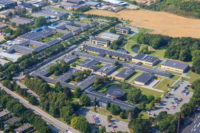USDA celebrates 100 years of ag innovation at Fort Keogh Livestock and Range Research Laboratory
ARS Fort Keogh Livestock and Range Research Laboratory, in partnership with Montana State University’s Montana Agricultural Experiment Station, has been helping producers improve agricultural production nationwide since 1924.

Photo courtesy of ARS-USDA Dr. Jay Angerer
The U.S. Department of Agriculture Agricultural Research Service is celebrating the 100-year anniversary of Fort Keogh Livestock and Range Research Laboratory and its past and present contributions to the livestock industry and scientific community.
For a century, ARS Fort Keogh Livestock and Range Research Laboratory, in partnership with Montana State University’s Montana Agricultural Experiment Station, has been innovating in livestock, poultry and swine performance and genetic enhancement through their work on animal breeding and nutrition. Their work has helped producers improve agricultural production nationwide since 1924.
“The ARS scientists at Fort Keogh have a long-standing history of collaborating with stakeholders to address the challenges of the livestock industry,” said ARS Administrator Dr. Simon Liu. “Through their pioneering practices, they have made significant strides in research related to cattle nutrition, reproductive efficiency, and genetic improvement.”
The development of a closed herd of purebred Hereford cattle named Line One is the product of 90 years of ARS’ collaborative work with MSU. This research project is one of the world's oldest beef cattle selection experiments, and it has become a cornerstone for modern genetic evaluation of beef cattle.
The laboratory's long-term research on stocking rates (numbers of livestock or unit area over a given period) on Northern Great Plains rangelands provides stakeholders with a guide for improving rangeland health in semi-arid rangelands dominated by cool-season plants. In addition, research on the impact of livestock grazing after fire activity during the growing season, focusing primarily on the effects on rangeland vegetation types commonly found in the Northern Great Plains, resulted in revisions to the post-fire grazing recommendations used by land management agencies.
These accomplishments wouldn't have been possible without collaborations with a diverse group of organizations, universities, beef commodity interest groups, and federal and state government agencies.
"The historic partnerships at Fort Keogh have led to dozens of Montana State students, staff, and faculty working with ARS scientists on hands-on research to benefit our state's largest industry," said Sreekala Bajwa, vice president, dean & director, MSU, College of Agriculture & Montana Agricultural Experiment Station. "I would like to extend sincere gratitude to all of our past and present collaborators at Fort Keogh and look forward to another 100 years of productive partnership that will keep Montana agriculture strong."
The USDA-Agricultural Research Service Fort Keogh Livestock and Range Research Laboratory's scientific legacy is rooted in decades of combined research on inbreeding and selection, spanning the performance of sheep, milking shorthorn cattle, horses, turkeys, swine and beef cattle. This research, which began in 1924, has evolved over the years. Since 1986, the laboratory has transitioned to a more specific focus on beef cattle, including research on cattle genetics, reproductive physiology, and nutrition.
“Our goal is to continue our mission to collaboratively research and develop ecologically and economically sustainable range management and livestock production practices that meet customer needs for the next 100 years,” said Jay Angerer, research leader and supervisory research rangeland management specialist at the Livestock and Range Research Laboratory.
Leaders from MSU, Montana Dept. of Agriculture, Montana Stockgrowers Association, and U.S. Representative Matt Rosendale (Montana) also provided remarks during the event highlighting the laboratory's accomplishments.
Source: USDA's ARS
Looking for a reprint of this article?
From high-res PDFs to custom plaques, order your copy today!






